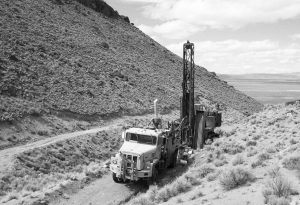Although molybdenum production is already under way at the Ashdown mine near Denio, Nev., 60-40 joint-venture partners Golden Phoenix Minerals (GPXM-O) and Win-Eldrich Mines (WEX-V, WIDMF-O) have released a technical report, feasibility study and reserve estimate.
In 2007, about 396,000 lbs. of molybdenum were produced from the mine and sold at an average price of US$31 per lb.
Current reserves total nearly 117,000 tons grading 1.65% molybdenum for a total of 3.8 million lbs. molybdenum, while resources are 182,000 tons grading 1.51% totalling 5.5 million lbs. moly.
A cutoff grade of 0.65% molybdenum was used and is based on a projected price of US$30 per lb. in 2008, declining to US$22.50 per lb. in 2011.
The mine life is currently estimated at 3.3 years from January 2008, with production expected to be 3.8 million lbs. with milling at a rate of 100 tons per day and a 90% recovery rate.
Operating costs are estimated at US$300 per ton while the life-of- mine average cost of producing 1 lb. molybdenum is US$10.10. Capital investment was pegged at US$5.35 million and the net present value of the project is thought to be US$35.3 million at an 8% discount rate.
The companies say that the deposit has exploration potential in three ways.
One would be to convert vacant reserve blocks in the current model into reserves. Some reserve blocks were not included in the reserve estimate because there were large gaps in drilling between the mineralized blocks or there wasn’t enough drilling done in certain blocks.
Another area with potential is the downdip and strike extensions of the Sylvia and Main veins below 450 ft., north and south of the 1,800-ft. strike length.
Finally, potential exists regionally. Anomalous molybdenite geochemistry has been demonstrated through wide-spaced drilling, rock-chip samples and in soil samples over 3 miles along the projected strike length of current reserves. Also, a few drill holes have intercepted vein mineralization similar to the Sylvia vein but the relationship is still unknown due to lack of drilling.
Mineralization was detected in the late 1800s but the area was eventually mined for gold, not molybdenum.
About 52,000 oz. of gold averaging 9.7 grams gold per tonne was produced from high-grade veins up until 1942.
Two large quartz veins were the focus — the Sylvia and Main veins, with thickness stretching an average of 7 ft.
Between 1979 and 1984, about US$8 million was spent on exploration and drilling on the Ashdown property.
A reported 293 reverse-circulation and diamond holes were drilled for a total of 73,000 ft.
Bulk samples of molybdenite mineralization from the Sylvia vein were taken in 1982 and 1983, as well as about 5,900 ft. of underground diamond-drill holes to evaluate the ground conditions and delineate the Sylvia vein.
Molybdenum mineralization was detected between 105 and 630 ft. at depth over an area of 840 ft. wide and 1,800 ft. long.
The molybdenum price fell from about US$18 per lb. to US$3 per lb. in 1983, causing interest to shift from molybdenum back to gold.
When commodity prices began increasing in 2003, Win-Eldrich and Golden Phoenix started to talk about bringing Ashdown back into production.
In 2005, Win-Eldrich milled about 2,000 tons of ore that had been mined and stockpiled in 1983, producing about 37,000 lbs. molybdenum at an average price of US$25 per lb.
By 2006, Win-Eldrich and Golden Phoenix made their joint venture official and began producing a saleable molybdenum concentrate that December.


Be the first to comment on "Feasibility study for Ashdown moly mine"